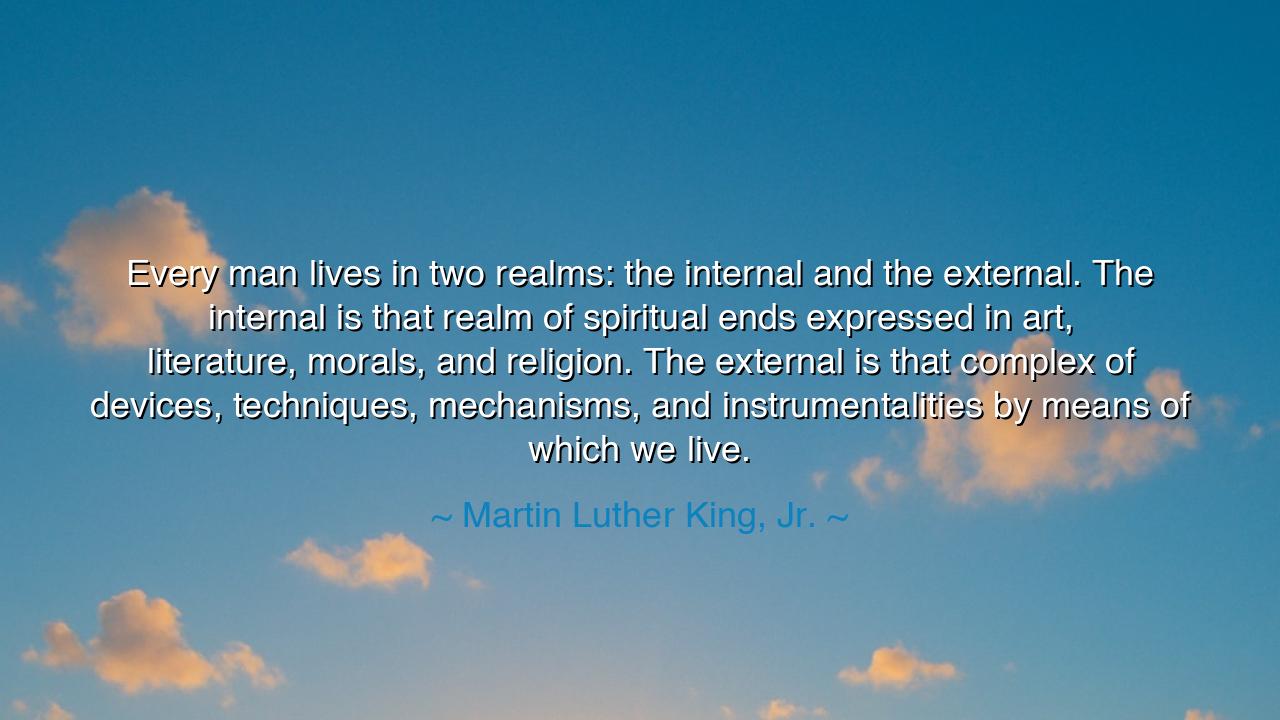
Every man lives in two realms: the internal and the external. The
Every man lives in two realms: the internal and the external. The internal is that realm of spiritual ends expressed in art, literature, morals, and religion. The external is that complex of devices, techniques, mechanisms, and instrumentalities by means of which we live.






Hear the luminous words of Martin Luther King, Jr., spoken with the cadence of a prophet and the clarity of a philosopher: “Every man lives in two realms: the internal and the external. The internal is that realm of spiritual ends expressed in art, literature, morals, and religion. The external is that complex of devices, techniques, mechanisms, and instrumentalities by means of which we live.” In these words, King reminds us that humanity is not only flesh and bone, nor only spirit and dream, but a union of both. To forget either realm is to become unbalanced, to lose the harmony of our true nature.
The internal realm is the sacred chamber of the soul. It is the realm of meaning, of ideals, of beauty. Here dwell the songs of poets, the visions of artists, the commandments of conscience, and the whispers of faith. It is invisible to the eye, yet it gives shape to all that we call civilization. Without this realm, the works of man are hollow shells. Without art, literature, morals, and religion, the heart grows barren, and even the most advanced society becomes a machine without a soul.
The external realm, by contrast, is the world of action, invention, and survival. It is the realm of the hammer and the plow, of the wheel and the engine, of science, medicine, and the tools by which we sustain life. It is visible and powerful, and it has brought forth great wonders. It gives us shelter, cures our diseases, and shortens the distance between nations. Yet King warns that this realm alone is not enough. Without guidance from the internal, the external becomes a monster—efficient, yet heartless.
History itself testifies to this truth. In the twentieth century, nations wielded mighty machines of war—airplanes, tanks, and atomic bombs—yet without the restraint of the internal realm, these devices brought only ruin. The horrors of Auschwitz and Hiroshima were not born of ignorance of technology but of the absence of conscience. The external realm triumphed in knowledge, but the internal realm was silenced, and thus progress became destruction.
Yet there are also shining examples of harmony. Consider Florence during the Renaissance. There, art, philosophy, and religion flourished alongside invention and science. Leonardo da Vinci painted the soul upon canvas and sketched the wings of flying machines. Michelangelo carved angels in stone while engineers raised domes that still defy the centuries. In that union of the internal and external, humanity reached heights that still inspire. Here we see King’s wisdom embodied: when both realms walk hand in hand, man reflects the divine.
The lesson, O listener of tomorrow, is this: you too dwell in both realms. You must tend to the external, for it sustains your body, but you must never neglect the internal, for it sustains your soul. A life consumed only with devices and gain will leave you empty. A life of only dreaming, without action, will leave you ungrounded. True greatness is found when your hands labor in the world while your heart listens to the voice of eternity.
Therefore, take action. Each day, give time to both realms. Work diligently, using the tools and techniques that life demands. But also pause, read, create, pray, reflect. Let your conscience guide your craft, and let your art inspire your labor. In this balance, you will live as King envisioned: not as a machine of the age, nor as a ghost detached from the earth, but as a whole being—body and spirit, external and internal, harmonized in the fullness of life.






AAdministratorAdministrator
Welcome, honored guests. Please leave a comment, we will respond soon